

Positive security cultures start with human risk management
Human Risk Management (HRM)
Human Risk Management (HRM) is the process of identifying, assessing, and mitigating risks associated with human behavior in relation to an employee's use of technology.
Cyberattacks can come from anywhere and target any workforce identity.Human risk management (HRM) helps your workforce effectively identify the full array of cyberattacks they face every day and proactively protect their accounts and data. Successful HRM programs identify cyberisks and apply action plans that either nudge, train, or orchestrate positive change.
Trust your workforce with the visibility and opportunity to actively protect from cyber threats.


Forrester predicts that 90% of data breaches will include the human element in 2024.
Predictions 2024: Cybersecurity, Risk, And Privacy

Human Risk Management naturally evolves from Security Awareness Training (SAT)
To truly address the evolving cyber risks facing organizations, a paradigm shift is required. Traditional SAT programs struggle quantifying the array of cyber risks the workforce faces every day. With targeted risk protection, security leaders can design, deploy, measure and report HRM action plans in real time.
A complete Human Risk Management (HRM) solution is required. Within an enterprise, HRM provides both the capability to manage your cybersecurity human risk, as well as the content and tools needed to truly engage your employees to change behaviors to have an impact on security culture. Using the full suite of HRM capabilities, enterprises proactively protect from risks before they evolve into incidents. Deploying HRM within the organization transforms your human risk into a proactive defense.



Traditional SAT program metrics such as training completion rates, quiz performance and engagement metrics are fundamentally flawed.
The Forrester Wave: Security Awareness & Training Solutions, 2022

The Three Pillars of Human Risk Management:
 Identify
Identify
.png) Protect
Protect
 Report
Report
Measuring your journey to true HRM
Engagement is mandate-driven and aligns with meeting compliance requirements en masse.
This is often the stated goal for most security awareness and training programs; however, it is only the beginning for Human Risk Management programs.
As programs mature, workforce engagement expands to targeted efforts focused on specific risks.
For example, a user is enrolled in training after a failed phishing simulation assessment. While this remedial-driven program has expanded beyond annual compliance requirements and often delivers improved, personalized results for each employee, it lacks a strong sense of individualized ownership of an employee’s impact to the security of their organization.
In this phase, engagement is incentive-based, offered by the security team.
Users start to take the lead in their own training to “win,” either through acknowledgement (champions programs and leaderboards) or rewards such as swag or paid time off (PTO). These incentives provide the catalyst for personal motivation.
Evangelists arise throughout the organization, personally motivated to improve cyber hygiene.
Workforce engagement is driven by security champions, who become advocates for security initiatives and understand the importance of strong cyber hygiene. Business leaders prioritize cyber-risk conversations, bring awareness to the risks specific to their department or line of business, and even incorporate human risk metrics as part of their performance goals or team objectives.
Increased individualized ownership of security by end users who are invested in the cause, both professionally and personally, is solidified.
Individuals clearly understand the relationship between their actions and the impact on security, and because of this, they attain a greater sense of ownership at work and at home. Programs that get to this stage typically have operationalized Human Risk Management, using data, processes, and/or technology, to truly change human behaviors at scale.

Feature
Human Risk Management Conference 2024
Join us for the 3rd Annual Human Risk Management Conference. Registration is now open.









